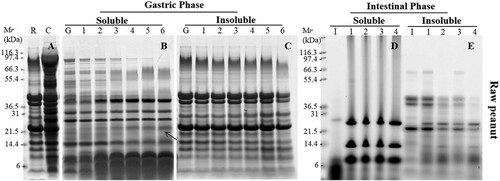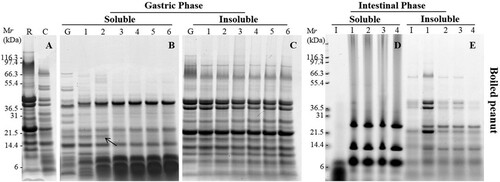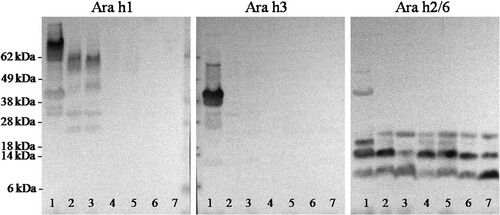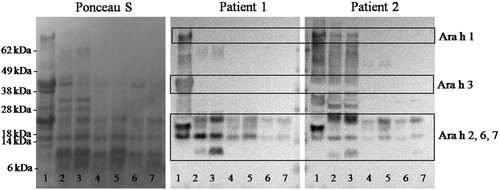Figures & data
Figure 1. SDS-PAGE analysis of simulated oral (A), oral-gastric (B,C) and oral-gastric-intestinal (D,E) digestion of raw peanut. R – undigested raw peanut extract; C – chew sample; G – no enzyme gastric control; I – no enzyme intestinal control; Panels B and C Lanes 1–6 are gastric digestion time points – 0.3, 2, 10, 40, 70 and 120 min; Panels D and E Lanes 1–4 are intestinal digestion time points – 5, 15, 30 and 120 min.

Table 1. Proteins identified in gels by tryptic digestion (bands annotated in (B ) and 3(B)).
Figure 2. SDS-PAGE analysis of simulated oral (A), oral-gastric (B,C) and oral-gastric-intestinal (D,E) digestion of roasted peanut. R – undigested roasted peanut extract; C – chew sample; G – no enzyme gastric control; I – no enzyme intestinal control; Panels B and C Lanes 1–6 are gastric digestion time points – 0.3, 2, 10, 40, 70 and 120 min; Panels D and E Lanes 1–4 are intestinal digestion time points – 5, 15, 30 and 120 min.

Figure 3. SDS-PAGE analysis of simulated oral (A), oral-gastric (B,C) and oral-gastric-intestinal (D,E) digestion of boiled peanut. R – undigested boiled peanut extract; C – chew sample; G – no enzyme gastric control; I – no enzyme intestinal control; Panels B and C Lanes 1–6 are gastric digestion time points – 0.3, 2, 10, 40, 70 and 120 min; Panels D and E Lanes 1–4 are intestinal digestion time points – 5, 15, 30 and 120 min.

Figure 4. Immunoblotting analysis of the soluble fraction of digested peanut and processing peanut. Immunoblots were developed using polyclonal antibody preparations to Ara h1, Ara h3 and Ara h 2/6. The order of the samples in lane 1: non-digested raw peanut; lanes 2, 4 and 6: soluble fractions after 10 min gastric digestion of raw peanut, roasted peanut and boiled peanut, respectively; lanes 3, 5 and 7: soluble fractions after 120 min gastric digestion of raw peanut, roasted peanut and boiled peanut, respectively.

Figure 5. IgE immunoreactivity of digested peanut and processing peanut using plasma from peanut-allergic patients. The order of the samples in lane 1: non-digested raw peanut; lanes 2, 4 and 6: soluble fractions after 10 min gastric digestion of raw peanut, roasted peanut and boiled peanut, respectively; lanes 3, 5 and 7: soluble fractions after 120 min gastric digestion of raw peanut, roasted peanut and boiled peanut, respectively.


